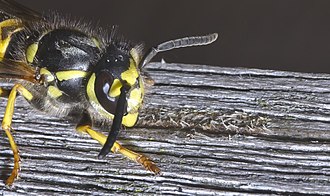German wasp
| German wasp | ||||||||||||
|---|---|---|---|---|---|---|---|---|---|---|---|---|

German wasp ( Vespula germanica ) |
||||||||||||
| Systematics | ||||||||||||
|
||||||||||||
| Scientific name | ||||||||||||
| Vespula germanica | ||||||||||||
| ( Fabricius , 1793) |
The German wasp ( Vespula germanica ) is a species of the short-headed wasps ( Vespula ) and is therefore one of the real wasps (Vespinae).
features
The queen is up to 20 millimeters tall, workers remain significantly smaller at twelve to sixteen millimeters and drones at thirteen to seventeen millimeters. They have the black and yellow warning color typical of wasps.
As a distinguishing feature from other social wasps , the German Wasp has a drawing with one to three black dots or a small straight, often interrupted black line on its head shield, also known as the forehead plate or clypeus .
As with all short-headed wasps , the narrow, only 0.2-0.3 mm wide space between the lower edge of the eye and the base of the upper jaw ( mandible ) is also found in the German wasp , which is no larger in the case of the queen and the worker than in the male is only slightly larger than the diameter of an ocellus (point eye) on the vertex.
Occurrence
The German wasp occurs in almost all forms of landscape, often also in human settlement areas. It usually prefers dark cavities to create its nest.
The species is naturally widespread in almost the entire Palearctic : in all of Europe (north to Scandinavia), in North Africa, in all of North Asia, east to Korea, Sakhalin and Japan, south to Syria, Iran, northern India, central China and Taiwan . In addition, it was introduced and naturalized in most regions of the world with a similar climate, such as Iceland, North America, southern South America, South Africa, Australia with Tasmania, New Zealand.
Way of life
Nest building and state foundation
The German Wasp often builds its nest underground. Their states are only annual. The young queen , who winters in a hiding place with a suitable microclimate , founds the state on her own. She begins building nests in spring mostly underground in found mouse and mole tunnels , which are later expanded into larger caves; but often also in buildings, for example in roof trusses. The young queen first attaches a small lampshade made of chewed and saliva-lined wood fibers, which are as brittle as possible, to the ceiling of the cave or the corresponding substrate . Underneath, she works a delicate honeycomb made of several horizontally adjacent hexagonal cells that are very similar to those of bees . However, they are not arranged vertically, but horizontally, with the opening facing downwards, and the chamber walls are also significantly thinner and lighter than those of the bees. Due to the use of superficially weathered wood that z. B. is gnawed from pasture stakes and wooden fences (where you can watch the wasps well), the nest is gray in color and differs from that of the closely related, similar common wasp , which uses rotten wood (rotting tree trunks, branches, etc.) which gives their nest a light, beige-colored appearance.
In the course of the year, the structure, which is surrounded by a leafy coat, grows to the size of a pumpkin, then usually consists of five to seven interconnected honeycombs. The state then comprises around 3,000 to 4,000 individuals, in some cases, however, up to 7,000 animals. In exceptional cases, huge nests with a circumference of up to two meters have been reported. In countries with warmer winters, where the German wasp was naturalized, there are even nests of several years which can then become even larger with more than 10,000 animals.
Wasp state
The entire state is organized according to the division of labor, which means that the individuals are either occupied with building nests, cleaning cells, feeding larvae, caring for the queen or procuring food. The brood care is as intensive as with the bees. In the wasps, however , the larvae mainly get to eat insects .
literature
- Rolf Witt: Observe wasps, determine . Naturbuch / Weltbild, Augsburg 1998, ISBN 3-89440-243-1
- Heiko Bellmann : bees, wasps, ants. Hymenoptera of Central Europe . Franckh-Kosmos, Stuttgart 1995, ISBN 3-440-06932-X
- Jirí Zahradnik : bees, wasps, ants. The hymenoptera of Central Europe . Franckh-Kosmos, Stuttgart 1985, ISBN 3-440-05445-4
Individual evidence
- ↑ James M. Carpenter1 & Jun-ichi Kojima (1997): Checklist of the species in the subfamily Vespinae (Insecta: Hymenoptera: Vespidae). Natural History Bulletin Ibaraki University 1: 51-92.
- ^ CR Thomas: The European wasp (Vespula germánica Fab.) In New Zealand. New Zealand Department of Scientific and Industrial Research Information Series no. 27, 1960, 74 pp.
Web links
- Vespula germanica at Fauna Europaea



